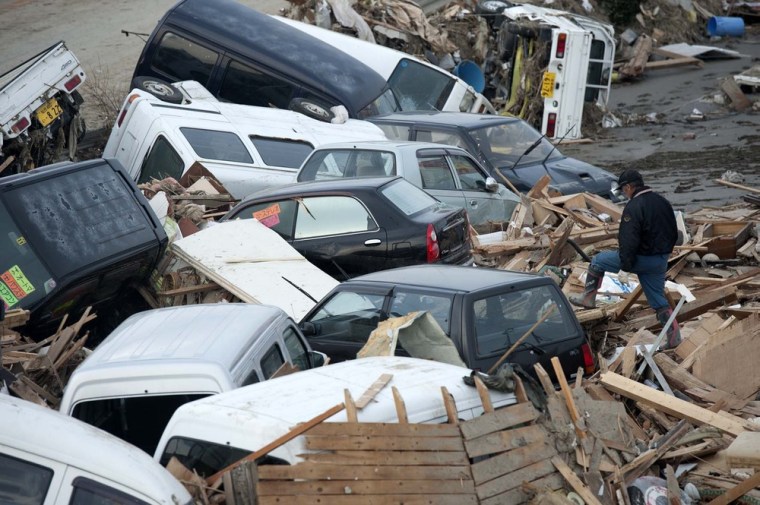Japan’s massive earthquake, tsunami and nuclear disaster is likely to be the costliest natural catastrophe on record but the impact on the private insurance industry probably will not surpass that of Hurricane Katrina in 2005.
That is in part because Japanese homeowners and businesses rely heavily on a government-funded earthquake insurance system, rather than private insurance. As a result, only about 14 to 17 percent of Japanese homes have private earthquake insurance, according to estimates from the Reinsurance Association of America.
The Japanese system also puts a cap on the total claims paid out by both the government and private insurers. If total claims top roughly $60 billion, payouts are pro-rated — meaning that homeowners and businesses would have to settle for a partial coverage of their losses.
That leaves a relatively small payout for the private insurance industry, and it will be spread among several players.
Still, the overall cost of last week's 9.0 magnitude quake and resulting tsunami will be astronomical. Private bank estimates put total losses at $180 billion, a figure that could go higher if radiation leaks from a crippled nuclear plant inflict further damage
The figure would make the Japan quake the costliest natural catastrophe on record — larger than Hurricane Katrina, which created $125 billion in losses and killed some 1,300 people in 2005. About half of Katrina's losses were covered by insurance, resulting in a $66 billion hit to the insurance industry.
Thanks to the liability limits and a long-standing financial backstop from the Japanese government, the cost of the Sendai quake to the private insurance industry will probably be far lower. The most widely cited estimates of insured losses comes from AIR Worldwide, an insurance consultant, which puts those losses in the range of $15 billion to $35 billion. That number, which doesn't cover tsunami damage, could rise, according to Jayanta Guin, AIR Worldwide's head of research and modeling.
"It's still early in the aftermath; we have been running hundreds of computer simulations taking all the geophysical data and simulating the ground motion and estimating damage based on this simulation," he said. "We're working through the details to see if we can refine it."
Insurance premiums rose in the aftermath of Katrina, but are unlikely to do so this time around, analysts say
The insurance impact from the Sendai quake likely will be absorbed mainly by the Japanese domestic insurance property-casualty and life insurance industries, "with a healthy dose being shared by the global reinsurance community," said Robert Hartwig, president of the Insurance Information Institute, an industry group.
The biggest wild card to damage estimates is the threat to life and property from the crippled Fukushima Dai-ichi nuclear plant, which was leaking radiation. Those potential costs are unknowable, but the private insurance industry is fully shielded from the financial impact.
Under the Japanese Nuclear Act of 1961, operators of nuclear plants are not liable for any damage resulting from a "grave natural disaster of an exceptional nature," according to the reinsurance association. Tokyo Electric Power, the plant operator, has its own private property insurance for the plant, but damage caused by earthquakes and tsunamis is excluded from the policy, according to Stefan Schuermann, an analyst at the Swiss bank Vontobel.
"Those disasters are typically excluded from property and casualty policies," he said.
When insurance companies face payouts for large natural disasters like the Japan quake and tsunami, they typically rely on other, bigger insurers — so-called "reinsurers" that act as a backstop when losses get too big. After raising premiums following the huge losses from Katrina, the reinsurance industry currently holds surplus capital of $50 billion to $70 billion, according to investment bank Credit Suisse.
The financial hit to the reinsurance industry also will be tempered by payouts to private insurers from the Japanese government, which provides a separate earthquake reinsurance backstop for the Japanese insurance industry. All of this leaves global reinsurers well-positioned to handle what could be the costliest natural disaster in history.
That could help moderate another round of premium increases like the ones that followed the huge payouts from Hurricane Katrina.
Insurance premiums typically run in cycles, rising in so-called "hard" markets, when heavy losses force insurers to raise premiums, and falling in "soft" markets, when large cash cushions spark competition for new customers and discount pricing.
Though the cost of covering the Japan quake may be manageable, it follows a string of losses that have totaled more than $50 billion, including big payouts to cover damages from recent quakes in Chile and New Zealand and floods in Australia. So even before the Japan quake, the cycle was swinging back from the "soft" market created by surpluses accumulated post-Katrina.
But while premiums are expected to rise in Japan, analysts say consumers elsewhere in the world probably won't see big increases — unless and until another big disaster hits.
